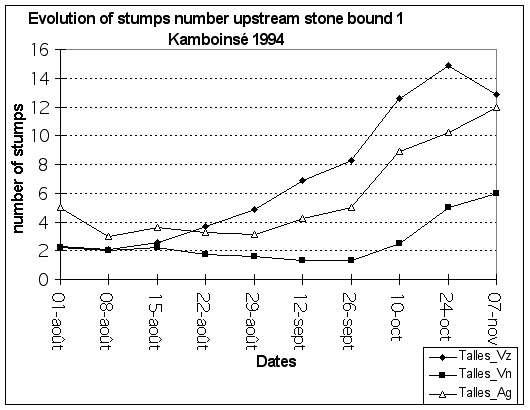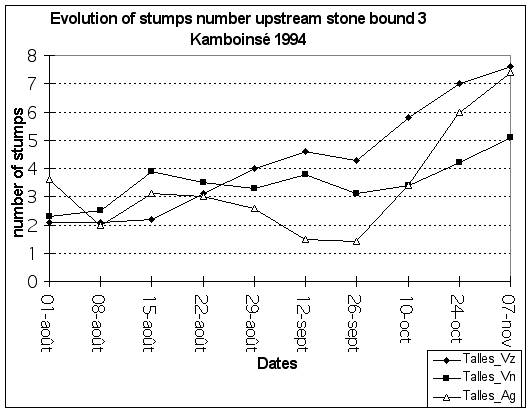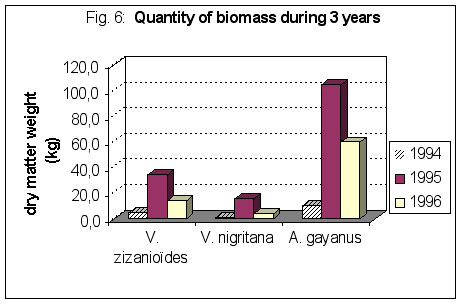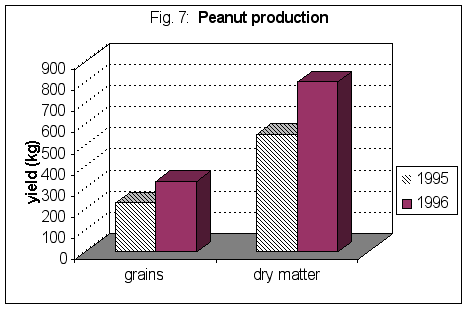
Role of vetiver grass in stone lines stabilisation in the central Plateau of Burkina Faso
R., Zougmoré, L., Thiombiano, F., Kambou and Z., Zida
Abstract
Burkina Faso is located in the Sahel zone. Soil erosion control measures have been emphasised on physical techniques like earth and stone bounds, small dikes and vegetative barriers. These techniques have succeeded but their realisation is limited by the work hardness and especially by the lack of stones in the long term. A trial held in the north and centre zone of Burkina allowed to evaluate the suitability and adaptability of Vetiveria zizanioïdes to be established in hedge rows. Two local species, Vetiveria nigritana and Andropogon gayanus have been associated for comparison. Theirs capacity to insure a good fixing of stone bounds and to establish durably hedge rows have been evaluated. Results after three years have shown that Vetiveria zizanioïdes and Andropogon gayanus are growing well upstream stone bounds and establish a very tight line that stabilise stone bounds. Plant regrowth rate, plant growth and spreading, and the biomass are more interesting for these two species despite severe attack of termites. On the other hand, the performance of Vetiveria nigritana is the least and seems rather to succeed in good humidity conditions such as bottom valleys.
Introduction
The Sahelian zone is confronted with the double problem of temporal and spatial rainfall variability, and soil erosion by high intensity of the rainfall which can reach I30 > 35 mmh-1 (Casenave et Valentin, 1989). The phenomenon is further worsened by an increasing scarcity of vegetation and by soil crusting (Lal, 1997; Morin, 1993). In Burkina Faso, Roose (1981) observed runoff that accounted for up to 40% of annual average rainfall, and considerable soil losses (4 to 8 tha-1/year) despite slopes of under 3%. This resulted in soil low productivity and to weak level of crop yields (Sédogo, 1993).
Soil erosion control has especially put emphasis on the implementation of techniques which allow to the soil to absorb the maximum of rain water (ploughing, mulching, tied ridging, hoeing, etc.), but also by large popularisation of physical measures such as earthen bounds, stones bounds, small dikes, etc (Fida, 1987, Mando et al., 2000). These techniques have shown tangible results and are much appreciated by farmers (Maatman and al., 1998). However, the problem of the work hardness during theirs realisation and the lack of stones in the long term is still actual. Thus, researches are nowadays increasingly centred on hedge rows and grass strips utilisation. When definitively installed, these measures are more durable and need a few up keeping. Andropogon sp. and Penissetum sp. are species which are traditionally used by farmers (Vlaar, 1992). Vetiver grass utilisation in hedgerows to reduce runoff, soil loss and to increase soil humidity is well known in several countries with similar agroclimatic conditions as Burkina Faso (India, Indonesia, Madagascar, Brazil, Australia, Chine, Philippines, Nigeria, etc.). It allows to break the slope length, decrease runoff velocity and increase infiltration opportunity time, reduce the erosivity and transport capacity of runoff, cause the deposition of erosion products, trap nutrients and induce terracing (Wilborts, 1995).
This study aims to evaluate the suitability and adaptability of Vetiveria zizanioïdes to be established in hedge rows, and to evaluate three species capacity to ensure a good fixing of stone bounds and to establish durably hedge rows.
Methodology
The trial is held in the agricultural research station of Kamboinsé, located at 12 km from Ouagadougou (Latitude north: 12°28; Longitude west: 1°32; Altitude: 296 m).The climate is north soudanian type with a long dry season and a rainy season witch starts in may (Guinko, 1984). The annual rainfall average of the last fifteen years is 750 mm during 6 months (May-October). The rainfall is characterised by a high temporal and spatial variation (figure 1). Average temperatures vary from 24 °C to 38 °C (Somé, 1989). Vegetation is septentrional soudanian type (Guinko, 1984) with species such as Butyrospermum paradoxum, Parkia biglobosa, Lannea microcarpa, Adansonia digitata, tamarindus indica and Acacia albida.
The experimental design has been installed in 1994 on a bare and degraded soil. The slope is 1,5 %. According to Zerbo (1995), soil type is Alfisol with pH of 6,7, a low organic matter content (<1%), nitrogen (0,04%) and phosphorus (0,33%).
Three stone bounds (SB) have been installed in July 1994 according to contour lines. Their length are 78m for SB1, 118m for SB2 and 142m for SB3. On each diguette (stone bound), 4 treatments are considered:
T0: stone bound without grass strip
Tvz : stone bound + Vetiveria zizanioïdes grass strip
Tvn: stone bound + Vetiveria nigritana grass strip
Tag: stone bound + Andropogon gayanus grass strip
Lines of plantation are situated 30 cm upstream of the diguette and distance between stumps is 20 cm for all species. Plants have been planted on 27 July 1994. A 2 m interval is left between treatments. The diguettes are approximately 33 m spaced (Zougmoré and al., 2000). The field has been cultivated with peanut.
Measures done during the 3 years of study are :
Results and discussions
Soil water content
Soil water content reach 17 % despite measure have been done in the end of September, when rainfall becomes erratic. The analysis of figure 2 shows that there is a soil humidity gradient in relation with stone bounds. Thus, soil water content is decreasing when moving away from upstream stone bounds. The highest water content was observed behind the stone bound (upstream). Water content is increasing from the first stone bound to that situated more lower (downward slope).
Plants regrowth rate
Two weeks after planting (1994), stumps regrowth is good, notably for Vetiveria zizanioïdes and Andropogon gayanus (figure 3). The average plant regrowth rate was 97% for Vetiveria zizanioïdes, 66 % for Vetiveria nigritana and 82 % for Andropogon gayanus. However, the regrowth level of Vetiveria zizanioïdes and Andropogon gayanus is homogeneous on the 3 stones bounds but rather increasing from first diguette to third diguette for Vetiveria nigritana.
In the beginning of the 1995 rainy season, i.e., after eight months of drought, plant regrowth rate has decreased for all species. Values obtained are 85% for Vetiveria zizanioïdes, 68% for Andropogon gayanus and 34% Vetiveria nigritana. In 1996, the regrowth was better than in 1995. A planting out has been done in 1995 to replace stumps died during the dry period.
During the three years, Vetiveria zizanioïdes and Andropogon gayanus have shown a good capacity of stumps regrowth (>80 %). On the other hand, Vetiveria nigritana has appeared less resistant to drought with an average regrowth rate of 51 %.
Plants height evolution
During the first month after planting, plants growth has been slow for the 3 species (figure 4). Then the growth becomes fast during rainy month of august and september before it stabilises in the end of the rainy season. The maximal height 103 days (27-July to 07-November) after planting was 103,5 cm for Vetiver grasses, and 203 cm for Andropogon gayanus. The flowering was realised for all species from the mi-October. The comparison between stone bounds didn’t show important variations of height. In second year, plants height increased appreciably reaching 3 m for Andropogon gayanus, 2,3 m for Vetiveria nigritana and 1,5m for Vetiveria zizanioïdes. The greatest height for Andropogon gayanus and Vetiveria zizanioïdes are obtained on the intermediate diguette while for Vetiveria nigritana, the maximal height is observed uphill the first diguette.
Evolution of stumps number
On figure 5, the number of stumps in 1994 increases globally from 2 to 6 for Vetiveria nigritana, 2 to 14 for Vetiveria zizanioïdes and from 2 to 12 for Andropogon gayanus. Therefore, Vetiveria zizanioïdes shoots up more than Vetiveria nigritana. Comparisons between stones bounds shows that the number of stumps decreases from first stone bound to third one for and Vetiveria zizanioïdes. On the other hand, for Vetiveria nigritana, the number of stumps decreases from first tone bound to the third one witch is situated downslope.
The next year (1995), the number of stumps per plant has strongly increased and has reached 110 for Andropogon gayanus, 36 for Vetiveria zizanioïdes and 27 for Vetiveria nigritana. During the third year, the number of stumps has stilled similar to that observed in 1995.
Biomass production and resistance to termites attack
The quantity of dry matter has increased during the first two years, then has decreased in 1996 (figure 6). Andropogon gayanus produced more dry matter than the two Vetiver species. Nevertheless, Vetiveria zizanioïdes biomass production was the double of that of Vetiveria nigritana.
Peanut grain production in 1995 and 1996 has also increased (figure 7). This could be related to soil physical and chemical properties improvement by stone bounds and grass strips. The comparison of the three species concluded that Vetiveria zizanioïdes and Andropogon gayanus suitability was interesting upstream the three diguettes. It was upstream the first diguette that Vetiveria zizanioïdes obtained the best productions of biomass, despite the low rate of soil water content at this zone. On the other hand, Vetiveria nigritana grow better upstream downward stone bound, demonstrating that this specie is more demanding in term of humidity. Indeed, this specie grows traditionally in bottoms and humid zones. The results are similar concerning stumps number and plants height. Following an attack of termites in the beginning of 1995 rainy season, Vetiveria zizanioïdes shoots have been able to resist better than the two other species.
Conclusion
This study showed that among the three tested species, Andropogon gayanus and Vetiveria zizanioïdes was the most suitable for stone bounds stabilisation. On a degraded soil, hedge row fixation have been effective upstream stone bounds only one year after plantation. The two species hedge rows showed a resistance to termites attacks during the dry season so that their regrowth rate at the beginning of the following rainy season was satisfactory. Vetiveria nigritana seems to succeed in good humidity conditions. Because of the multiple domestically uses of these species products by farmers (thatch of hut roofs, matting, straw hat, hangars, etc), a large diffusion of herbaceous hedge rows with these species becomes a primordial objective for local development agencies in order to promote sustainable management of the present limited natural resources in the Sahel.
References
Casenave, A., Valentin C., 1989. Les états de surface de la zone sahélienne; influence sur l'infiltration. ORSTOM, PARIS; 229p.
FIDA, 1987. Rapport d'évaluation du PS/CES/AGF dans le Plateau Central du Burkina Faso; n°0172-BF; 58 p + annexes.
Guinko, S., 1984. Végétation de la Haute Volta. Thèse de doctorat es sciences naturelles, Univ. Bordeaux III. 381p.
Lal, R., 1997. Soil quality and sustainability. In : Lal, R., W.H. Blum, C. Valentine and B.A. Stewart. pp 17-31. Methods for assessment of soil degradation. CRC PRESS. Boca Raton, New York.
Mando, A., Zougmoré, R., Zombré, N.P., Hien, V., 2000. Réhabilitation des sols dégradés dans les zones semi-arides de l'Afrique sub-saharienne. In : Floret, C., Pontanier, R., (Eds.), La jachère en Afrique tropicale; de la jachère naturelle à la jachère améliorée: le point des connaissances, John Libbey Eurotext, Paris (in press).
Morin, J., 1993. Soil crusting and sealing in West Africa and possible approaches to improved management. in Soil tillage in Africa: needs and challenges; FAO soils Bulletin ; 69 pp : 95-128.
Sédogo, M., 1993. Evolution des sols ferrugineux lessivés sous culture: incidence des modes de gestion sur la fertilité. Thèse Docteur es sciences, Univ.Nat. de Côte d'Ivoire. 332p.
Somé, L., 1989. Diagnostic agropédoclimatique du risque de sécheresse au Burkina Faso. Etude de quelques techniques améliorant la résistance pour les cultures de sorgho, de mil et de maïs. Thèse Univ. de Montpellier, sciences du Languedoc.
Vlaar, J.C.J., 1992. Les techniques de conservation des eaux et des sols dans les pays du Sahel. CIEH/UAW; 99p.
Wilborts, M., 1995. Water conservation using vegetative barriers. Modelling the effectivness of contour vegetative barriers on soil moisture storage in the arid lands of Rajasthan, India. PMSc thesis, Wageningen, 68p.
World Bank, 1993. Vetiver grass, the hedge against erosion. 78p.
Zerbo, L., 1995. Caractérisation des sols des stations de recherches agricoles de l’INERA, Burkina Faso; Rapport INERA. 114p.
Zougmoré, R., Guillobez, S., Kambou, N.F., Son, G., 2000b. Runoff and sorghum performance as affected by the spacing of stone lines in the semiarid Sahelian zone. Soil & Tillage Research 56; 3-4 : 175 - 183.

Figure 2: Water content at different distances from stone lines; (a) transect 1, (b) transect 2

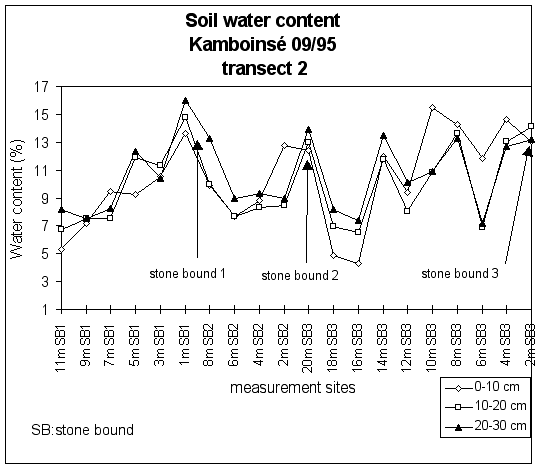
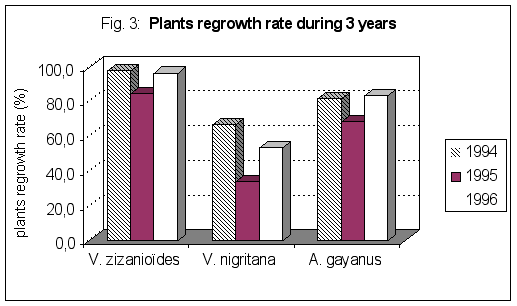
Figure 4: Evolution of plants height
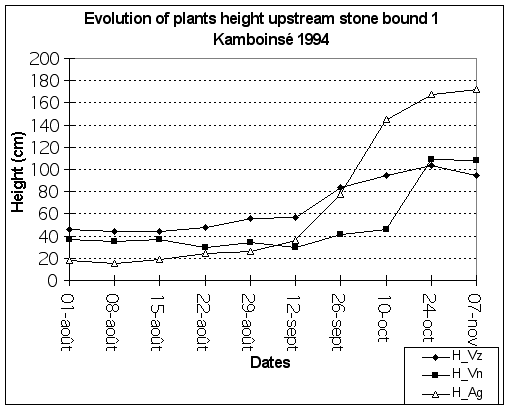
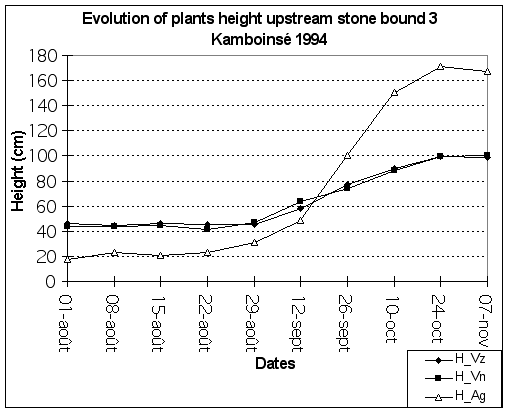
Figure 5: Evolution of stumps number
